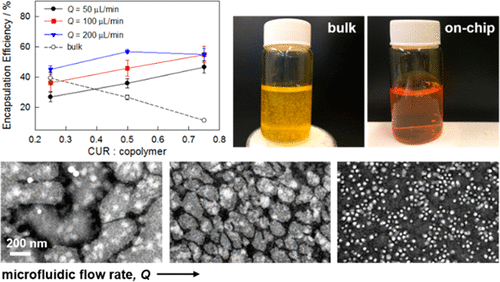当前位置:
X-MOL 学术
›
Mol. Pharmaceutics
›
论文详情
Our official English website, www.x-mol.net, welcomes your
feedback! (Note: you will need to create a separate account there.)
Microfluidic Processing Approach to Controlling Drug Delivery Properties of Curcumin-Loaded Block Copolymer Nanoparticles
Molecular Pharmaceutics ( IF 4.5 ) Pub Date : 2018-09-04 00:00:00 , DOI: 10.1021/acs.molpharmaceut.8b00529 Ruyao Chen 1 , Jeremy E. Wulff 1 , Matthew G. Moffitt 1
Molecular Pharmaceutics ( IF 4.5 ) Pub Date : 2018-09-04 00:00:00 , DOI: 10.1021/acs.molpharmaceut.8b00529 Ruyao Chen 1 , Jeremy E. Wulff 1 , Matthew G. Moffitt 1
Affiliation

|
We apply gas–liquid microfluidic reactors containing flow-variable, high-shear “hot spots” to produce curcumin-loaded polymer nanoparticles (CUR-PNPs) comprised of poly(caprolactone)-block-poly(ethylene oxide) (PCL-b-PEO) block copolymers at various flow rates and CUR loading ratios. CUR-PNPs prepared using the conventional nanoprecipitation method (bulk method) showed decreased encapsulation efficiency and increased drug precipitation as the loading ratio increased. However, CUR-PNPs prepared by microfluidic manufacturing showed both increased encapsulation efficiency and increased drug loading as either the flow rate or the loading ratio increased. This enabled microfluidic CUR loading percentages of up to 30% to be achieved in this study, which to our knowledge is a record for block copolymer PNPs. As well, it is shown that increased flow rate of microfluidic manufacturing leads to decreased mean CUR-PNP sizes (down to ∼50 nm) and narrower size distributions, along with significantly different CUR release kinetics compared to CUR-PNPs prepared at slower flow rates. In vitro antiproliferation experiments against MDA-MB-231 cells give an average IC50 value of 24 μM for CUR-PNPs compared to 13 μM for free CUR at the same incubation time of 72 h. Compared to conventional bulk and single-phase microfluidic strategies, this unique two-phase reactor represents an exciting manufacturing platform for optimizing polymeric CUR nanomedicines though flow-directed shear processing.
中文翻译:

微流体处理方法来控制姜黄素负载的嵌段共聚物纳米颗粒的药物传递性质。
我们将含有流可变,高剪切的“热点”于包括聚(己内酯)的生产负载姜黄素的聚合物纳米颗粒(CUR-的PNP)气-液反应器的微流体-嵌段-聚(环氧乙烷)(PCL- b-PEO)嵌段共聚物在各种流速和CUR负载比下。使用常规的纳米沉淀法(本体法)制备的CUR-PNPs随载量比的增加显示出降低的包封效率和增加的药物沉淀。然而,通过微流体制造制备的CUR-PNP显示出随着流速或载量比的增加包封效率和药物载量的增加。这使这项研究中的微流体CUR加载百分比达到了30%,据我们所知,这是嵌段共聚物PNP的记录。同样,研究表明,微流体制造的流速增加会导致平均CUR-PNP尺寸减小(低至约50 nm)和尺寸分布变窄,在72小时的相同孵育时间下,针对MDA-MB-231细胞的体外抗增殖实验得出CUR-PNP的平均IC 50值为24μM,而游离CUR的平均IC 50值为13μM。与常规的批量和单相微流控策略相比,这种独特的两相反应器代表了一个令人兴奋的制造平台,可通过流控剪切工艺优化聚合物CUR纳米药物。
更新日期:2018-09-04
中文翻译:

微流体处理方法来控制姜黄素负载的嵌段共聚物纳米颗粒的药物传递性质。
我们将含有流可变,高剪切的“热点”于包括聚(己内酯)的生产负载姜黄素的聚合物纳米颗粒(CUR-的PNP)气-液反应器的微流体-嵌段-聚(环氧乙烷)(PCL- b-PEO)嵌段共聚物在各种流速和CUR负载比下。使用常规的纳米沉淀法(本体法)制备的CUR-PNPs随载量比的增加显示出降低的包封效率和增加的药物沉淀。然而,通过微流体制造制备的CUR-PNP显示出随着流速或载量比的增加包封效率和药物载量的增加。这使这项研究中的微流体CUR加载百分比达到了30%,据我们所知,这是嵌段共聚物PNP的记录。同样,研究表明,微流体制造的流速增加会导致平均CUR-PNP尺寸减小(低至约50 nm)和尺寸分布变窄,在72小时的相同孵育时间下,针对MDA-MB-231细胞的体外抗增殖实验得出CUR-PNP的平均IC 50值为24μM,而游离CUR的平均IC 50值为13μM。与常规的批量和单相微流控策略相比,这种独特的两相反应器代表了一个令人兴奋的制造平台,可通过流控剪切工艺优化聚合物CUR纳米药物。











































 京公网安备 11010802027423号
京公网安备 11010802027423号